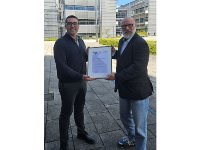Mittelstandspresse
01.07.2025
WITec Paper Award 2025 winners announced
This year’s prizes reward scientists for their excellent work in material analysis, battery research and medical science.

Ulm, 01.07.2025 (PresseBox) - Oxford Instruments celebrates the WITec Paper Award 2025, recognising the exceptional scientific contributions from scientists in Germany and Poland. Their innovative work advances research in materials, batteries and medical sciences, using WITec Raman technology. We congratulate the winners on their achievements and thank the participants from all over the world and across a wide spectrum of research fields for sharing their great work. Our team and the Paper Award Jury look forward to receiving many fascinating contributions for next year’s competition.
GOLD: Shahrouz Amini, Tingting Zhu, Hajar Razi, Erika Griesshaber, Peter Werner and Peter Fratzl (2024) In operando 3D mapping of elastic deformation fields in crystalline solids. Matter 7(7): 2591-2608. DOI: 10.1016/j.matt.2024.06.006
SILVER: Umair Nisar, Florian Klein, Claudia Pfeifer, Margret Wohlfahrt-Mehrens, Markus Hölzle and Peter Axmann (2025) Elucidating the nature of secondary phases in LiNi0.5Mn1.5O4 cathode materials using correlative Raman-SEM microscopy. Energy Storage Materials 74: 103905. DOI: 10.1016/j.ensm.2024.103905
BRONZE: Patrycja Leszczenko, Anna M. Nowakowska, Patrycja Dawiec, Karolina Czuja, Justyna Jakubowska, Marta Zabczynska, Agata Pastorczak, Kinga Ostrowska, Szymon Tott, Wojciech Mlynarski, Malgorzata Baranska and Katarzyna Majzner (2024) Advancing triage of acute lymphoblastic leukaemia subtypes diagnosis: label-free Raman spectroscopy for precise single-cell phenotyping and subtype classification. Analyst 149(22): 5443-5454. DOI: 10.1039/d4an00956h
For a list of all previous award-winning publications, please visit the official WITec Paper Award website.
The Paper Award GOLD: Visualizing material strain under pressure in 3D
Characterising the microstructure and strain in a material under applied force is crucial for evaluating its mechanical behaviour. However, it can be challenging to investigate force-induced effects in detail and at a high spatial resolution, especially when the deformations are reversible such as in elastic deformations.
As a solution, this year’s Paper Award GOLD winner, Shahrouz Amini and his colleagues from the Max Planck Institute of Colloids and Interfaces in Potsdam, Germany, developed a method called 3D-RISM. This method combines Oxford Instruments’ confocal Raman microscope technology with nanoindentation in one setup. It allowed the researchers to visualise elastic deformation fields (EDFs) in operando under a controlled indentation force at high resolution and even underneath the material’s surface.
Using 3D-RISM, Amini and his colleagues visualised the pressure-induced microstructure and strain in complex materials such as biological and geological calcites. Additionally, they were able to analyse the changes happening in the material with increasing force, when EDFs transformed into inelastic deformations.
The authors conclude that “3D-RISM can be an important step toward a quantitative understanding of the evolution of complex, elastic deformations” and “opens new avenues for unravelling the interplay between elastic anisotropy, materials’ microarchitecture, and mechanical performance in hybrid materials and microdevices”.
The Paper Award SILVER: Resolving secondary phases in next-generation battery materials
Searching for new cathode materials for lithium-ion batteries (LIBs) is an ongoing challenge with the goal of finding more sustainable materials that are independent of rare earth elements such as cobalt. One promising candidate is LNMO (LiNi0.5Mn1.5O4), however obstacles such as the interfacial instability and the formation of secondary phases during the high-temperature calcination step have so far prevented the adoption of LNMO in commercial batteries.
In the work recognised with the Paper Award SILVER, Umair Nisar and a team from the Centre for Solar Energy and Hydrogen Research Baden-Württemberg (ZSW) successfully characterised the secondary phases formed in LNMO using correlative Raman and scanning electron microscopy (SEM). While standard techniques such as XRD were limited in resolving the individual phases, Raman imaging allowed the researchers to find and identify the chemical nature of multiple secondary phases in LNMO materials.
In particular, in LNMO synthesised at 1000°C, Nisar and his colleagues detected three distinct secondary phases, which they observed for the first time. Higher amounts of these secondary phases resulted in a lower discharge capacity of LNMO. In contrast, the long-term cycling performance and rate capability were not affected.
The authors conclude that the insights from their work are “crucial for advancing the development of LNMO cathode materials for next-generation LIBs.”
The Paper Award BRONZE: Classifying cells for leukaemia diagnosis
Acute lymphoblastic leukaemia (ALL) is a form of cancer that affects blood and bone marrow cells. The early and precise diagnosis of ALL, along with the differentiation between its two main subtypes, B-cell ALL and T-cell ALL, is crucial for effective treatment and improved survival chances.
The Paper Award BRONZE winners, Patrycja Leszczenko et al. from the Jagiellonian University in Krakow, Poland, have introduced a Raman-based approach as a fast and reliable alternative to traditional ALL diagnostic methods. By applying statistical analysis techniques such as PCA and PLS-DA, which are increasingly used to evaluate Raman signals within complex biological samples, Patrycja Leszczenko and her team have identified distinctive molecular signatures in the protein-lipid profile of leukemic cells. The supervised PLS-DA technique successfully differentiated malignant cells from their healthy counterparts, even when employing different cell preparation methods.
This demonstrates the method’s reliability for diagnostic purposes and leads the authors to the following conclusion: “The potential translational applications [of Raman spectroscopy] in clinical practices offer a promising avenue for an expedited and accurate leukaemia diagnosis, paving the way for more targeted and personalised therapeutic approaches.”
Participate in the WITec Paper Award 2026
Oxford instruments invites researchers from all fields of application in industry and academia to participate in the WITec Paper Award 2026. Articles are eligible if they were published in 2025 (in print or online) in a peer-reviewed journal and contain results obtained with an Oxford Instruments WITec microscope. Submit your publications as a PDF to papers.witec@oxinst.com by January 31, 2026.
About Oxford Instruments WITec
Oxford Instruments WITec pioneered 3D Raman imaging and correlative microscopy and continues to lead the industry with a product portfolio that offers speed, sensitivity and resolution without compromise. Raman, AFM and SNOM microscopes, select combinations thereof, and Raman-SEM (RISE) instruments can be configured for specific challenges in chemical and structural characterisation through a modular hardware and software architecture with built-in capacity for expansion. Research, development and production are located in Ulm, Germany.
About Oxford Instruments plc
Oxford Instruments provides academic and commercial organisations worldwide with market-leading scientific technology and expertise across its key market segments: materials analysis, semiconductors, and healthcare & life science. Innovation is the driving force behind Oxford Instruments' growth and success, supporting its core purpose to accelerate the breakthroughs that create a brighter future for our world. The vigorous search for new ways to make our world greener, healthier and more productive is driving unprecedented levels of R&D investment in new materials and techniques to support productivity and decarbonisation worldwide, creating a significant opportunity for Oxford Instruments to grow. Oxford Instruments holds a unique position to anticipate global drivers and connect academic researchers with commercial applications engineers, acting as a catalyst that powers real world progress. Founded in 1959 as the first technology business to be spun out from Oxford University, Oxford Instruments is now a global, FTSE250 company listed on the London Stock Exchange (OXIG). For more information, visit www.oxinst.com
Datei-Anlagen:

(1 MB)
1550756.attachment
The Paper Award 2025 Gold winner Dr. Shahrouz Amini (left) receives his Award from Oxford Instruments representative Thomas Olschewski.

(2 MB)
1550755.attachment
Dr. Nisar Umair (left) and his colleagues, Dr. Peter Axmann and Prof. Dr. Markus Hölzle (right), are honoured with the Paper Award Silver, presented by Stefan Gomes da Costa of Oxford Instruments.

(2 MB)
1550757.attachment
The Paper Award Bronze goes to Dr. Patrycja Leszczenko and her team, with the award presented by Maxime Tchaya from Oxford Instruments. From left to right: Dr. Katarzyna Majzner, Prof. Małgorzata Barańska, Dr.Patrycja Leszczenko, Dr. Anna Nowakowska, Maxime Tchaya, Patrycja Dawiec, and Dr. Szymon Tott.
- Mehr Infos zu dieser Meldung unter www.pressebox.de
- zurück zur Übersicht















